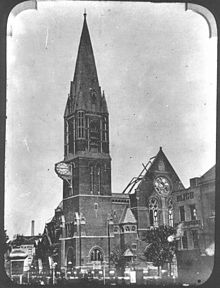
Stepney is a district in the East End of London in the London Borough of Tower Hamlets. The district is no longer officially defined, and is usually used to refer to a relatively small area. However, for much of its history the place name applied to a much larger manor and parish. Stepney Green is a remnant of a larger area of Common Land formerly known as Mile End Green.

Whitechapel is a district in the London Borough of Tower Hamlets in the East End of London, located 3.4 miles (5.5 km) east of Charing Cross.

St Dunstan's, Stepney, is an Anglican church which stands on a site that has been used for Christian worship for over a thousand years. It is located in Stepney High Street, in Stepney, London Borough of Tower Hamlets.

The Metropolitan Borough of Stepney was a Metropolitan borough in the County of London created in 1900. In 1965 it became part of the London Borough of Tower Hamlets.
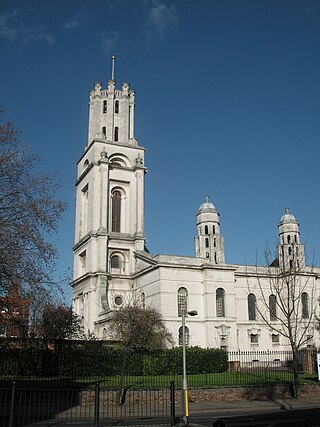
St George-in-the-East is an Anglican Church dedicated to Saint George; located on Cannon Street Road, between The Highway and Cable Street, in the East End of London. Behind the church lies St George's Gardens, the original graveyard.
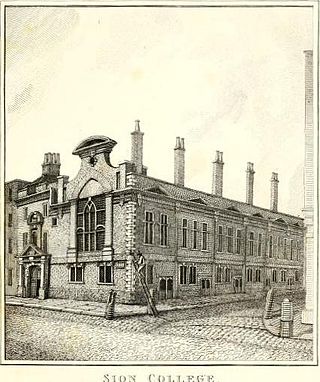
Sion College, in London, is an institution founded by royal charter in 1630 as a college, guild of parochial clergy and almshouse, under the 1623 will of Thomas White, vicar of St Dunstan's in the West.

St Paul's Church, Shadwell, is a Grade II* listed Church of England church, located between The Highway and Shadwell Basin, on the edge of Wapping, in the East End of London, England. The church has had varying fortunes over many centuries, and is now very active, having been supported recently by Holy Trinity Brompton Church.
Richard Hunne was an English merchant tailor in the City of London during the early years of the reign of Henry VIII (1509-1547). After a dispute with his priest over his infant son's funeral, Hunne sought to use the English common law courts to challenge the church's authority. In response, church officials arrested him for trial in an ecclesiastical court on the capital charge of heresy.
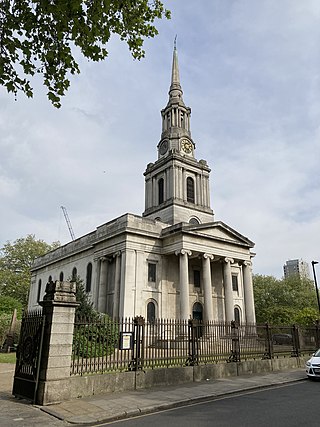
All Saints Church, Poplar, is a church in Newby Place, Poplar, London Borough of Tower Hamlets, and is the Church of England parish church of Poplar. It was built in 1821–3 to serve the newly created parish.

Bow Church is the parish church of St Mary and Holy Trinity, Stratford, Bow. It is located on a central reservation site in Bow Road, in Bow, in the London Borough of Tower Hamlets. There has been a church on the same site for approximately 700 years. The church was bombed in the Second World War, and the bell tower was reconstructed just after the war.
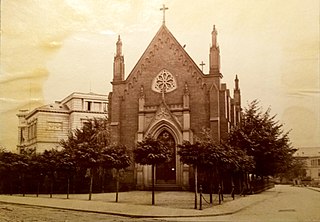
The Church of St Augustine of Canterbury, commonly known as The English church at Wiesbaden, is a Hessian heritage-listed Anglican parish church located at Frankfurter Strasse 3 in Wiesbaden, Germany. Built in 1865 and named in honour of St Augustine of Canterbury, it was designed in the Gothic Revival style by city engineer Theodor Goetz. The church remains historically, socially, and architecturally significant.

St Mary Magdalene Church is one of Hope Church Islington's places of worship, an Anglican church on Holloway Road in north London dedicated to Jesus' companion Mary Magdalene. It is located in St Mary Magdalene Gardens opposite Islington Central Library. St Mary Magdalene is part of the Parish of Hope Church Islington. In 2013 its sister church St David's on Westbourne road was reopened so St Mary Magdalene now functions as one of two worship sites of the Parish, with a single leadership and a staff team. The early 19th century building accommodates the activities of the church congregation, including church services, a winter night shelter, 'Mini Mags' – a toddlers group, and provides spaces to other users. Baptisms and confirmations, marriages and funerals are regularly held here. The building and its iron railings are both Grade II* listed structures, having first been listed in 1954.

St John at Hackney is a Grade II* listed Anglican Church in the heart of the London Borough of Hackney with a large capacity of around 2,000. It was built in 1792 to replace Hackney's medieval parish church, of which St Augustine's Tower remains, at the edge of its churchyard. The church faces north towards Clapton Square, with the nearby Sutton House and Hackney Central station also accessible from the churchyard to the east and south, respectively. As well as a thriving parish church, St John at Hackney has also become known as a notable music venue, playing host to the likes of Coldplay, Ed Sheeran, Emeli Sande, Robbie Williams, Griff and Interpol.
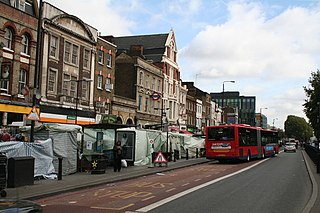
Whitechapel Road is a major arterial road in Whitechapel, Tower Hamlets, in the East End of London. It is named after a small chapel of ease dedicated to St Mary and connects Whitechapel High Street to the west with Mile End Road to the east. The road is part of the historic Roman road from London to Colchester, now the A11.

St. James' Episcopal Church, named for James the Greater, is a historic Episcopal church located in Manitowoc, Wisconsin. The only Episcopal church in Manitowoc County, St. James' is a "broad church" parish in the Diocese of Fond du Lac. It is the oldest continually operating congregation in Manitowoc County, first meeting in 1841. and organizing in 1848. The current church building, an example of Gothic Revival architecture, was consecrated in 1902. The congregation is active in community service and social justice ministries.

Altab Ali Park is a small park on the Whitechapel Road, in Whitechapel, London. Formerly known as St Mary's Park, it is the site of the old 14th-century, once whitewashed church, St Mary Matfelon, from which Whitechapel gets its name.

The Lutheran Church in Great Britain (LCiGB) is a small Protestant Christian church in the United Kingdom. The LCiGB is a member church of the Lutheran World Federation and of The Lutheran Council of Great Britain, the umbrella organisation for several Lutheran churches in Great Britain, many of which are chaplaincies or congregations that are closely related to Lutheran churches in other countries. The LCiGB is also a member of the Porvoo Communion of Anglican and Lutheran churches in Europe. It is, in common with many Lutheran churches, led by a bishop and a council of lay members and clergy elected at its annual synod. Tor Berger Jørgensen, former bishop of the Diocese of Sør-Hålogaland in the Church of Norway, was received as the fourth bishop of the LCiGB on 6 October 2019.

Saint Giles Episcopal Church was an Episcopal parish located in Moraga, California, United States, and part of the Episcopal Diocese of California. The community worshiped in the chapel at Saint Mary's College of California. Saint Giles closed permanently in 2017.
Richard Welton was an English Anglican non-juror.
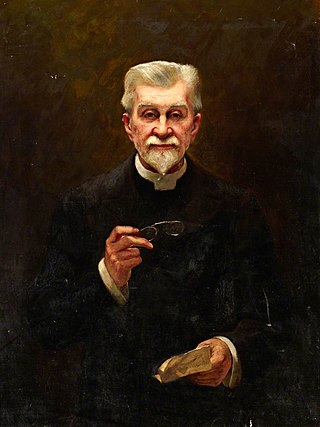
John Fenwick Kitto was an English Anglican clergyman and author. He founded and participated in various charitable causes, with a focus on London's East End. He served in positions including Rector of Whitechapel, Rector of Stepney, Vicar of St Martin-in-the-Fields, and Honorary Chaplain to the Queen.
